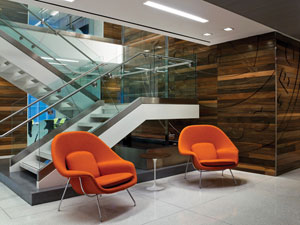Throw in the Towel: High-Speed, Energy-Efficient Hand Dryers Win Hands Down
The LCA Process
Saying a product or process is sustainable or more sustainable than the alternatives is increasingly common, as most architects can attest. But where's the irrefutable proof? Sometimes it is intuitive or it just makes sense. Other times, it can be so complex to identify and measure the variables that we might just take it on faith or throw up our hands.
Very few manufacturers submit their product or assembly to the detailed scrutiny of an environmental Life Cycle Assessment (LCA), which has been peer-reviewed by an independent panel of experts to ensure compliance with the ISO 14040 and 14044 standards. This approach is the 'Gold Standard' of rigor that addresses virtually all the environmental issues involved to give design professionals and building owners the indisputable evidence necessary to "prove it" with regard to sustainability. An LCA of hand drying systems was completed by Quantis of Salem, MA (www.quantis-intl.com) in July 2009.
The remainder of this course will examine the major steps of one such LCA process and discuss the methodology and its implications to architects as it relates to HSEE hand dryers.
The LCA method examines a broad range of environmental impacts at all stages of the product life cycle, including all material, energy, and pollutant inputs and outputs. For instance, global warming and the resulting climate change is one of 16 environmental categories or issues studied. (See nearby diagram)
The three systems compared in this study were a specific make and model of high-speed, energy-efficient (HSEE) electric hand dryer, a conventional electric hand dryer, and paper towels containing between 0% and 100% recycled content. Each system was evaluated to determine the environmental impact of providing 10 years of service (drying 260,000 pairs of hands or 500 uses per week), which was a conservative or lower range of use.
| USGBC decided to 'Throw in the Towel' at its HQ |
In addition, HSEE dryers may help K-12 facilities qualify for the following credits in the LEED for Schools rating system:
|
| Photo © Excel Dryer, Inc. All rights reserved. |
The peer-reviewed LCA is the only internationally recognized and accepted method for identifying and comparing the total environmental impacts of producing and consuming a product or A Life Cycle Assessment is comprised of the following four phases:
(a) Goal & Scope Definition: defining the purposes of the study, determining the boundaries for the system life cycle in question, and identifying important assumptions;
(b) Inventory Analysis: compiling a complete record of the important material and energy flows throughout the life-cycle, in addition to releases of pollutants and other environmental aspects being studied;
(c) Impact Assessment: using the inventory collide above to create a clear and concise picture of environmental impacts among a limited set of understandable impact categories; and
(d) Interpretation: identifying the meaning of the results of the inventory and impact assessment relative to the goals of the study.
An LCA is best practiced as an iterative process where the findings of each stage influence changes and improvements in the others to arrive at a study design that is of sufficient quality to meet the goals of the study and the principles, framework, requirements, and guidelines to perform an LCA as described by the international standards ISO series 14040 and 14044 (ISO 2006).





 USGBC's headquarters building is LEED Gold and its
22,000-sq. ft. interior is LEED Platinum. By using new
HSEE hand dryers in each restroom, USGBC saves energy,
which contributed to its Earth and Atmosphere Credit 1 -
Optimizing Energy Performance. A spokesman for USGBC
said, "We wanted dryers that would limit paper towel use and
minimize energy consumption; but we also wanted them to
work quickly and thoroughly. Not many hand dryers can make
that claim." The USGBC recently launched a new virtual tour of its Washington, D.C. headquarters. The tour includes an interactive look at the facility’s Next Generation Green Restroom and includes a CEU course that outlines how architects and interior designers can achieve similar water, energy and waste reduction results by following the specifications provided in the course. Additional information includes information on the practical, economic and environmental benefits of high-speed energy-efficient hand dryers, water use and trends, how to choose water-saving products and an explanation of how these products apply the new, best-practice green building.
USGBC's headquarters building is LEED Gold and its
22,000-sq. ft. interior is LEED Platinum. By using new
HSEE hand dryers in each restroom, USGBC saves energy,
which contributed to its Earth and Atmosphere Credit 1 -
Optimizing Energy Performance. A spokesman for USGBC
said, "We wanted dryers that would limit paper towel use and
minimize energy consumption; but we also wanted them to
work quickly and thoroughly. Not many hand dryers can make
that claim." The USGBC recently launched a new virtual tour of its Washington, D.C. headquarters. The tour includes an interactive look at the facility’s Next Generation Green Restroom and includes a CEU course that outlines how architects and interior designers can achieve similar water, energy and waste reduction results by following the specifications provided in the course. Additional information includes information on the practical, economic and environmental benefits of high-speed energy-efficient hand dryers, water use and trends, how to choose water-saving products and an explanation of how these products apply the new, best-practice green building. 



